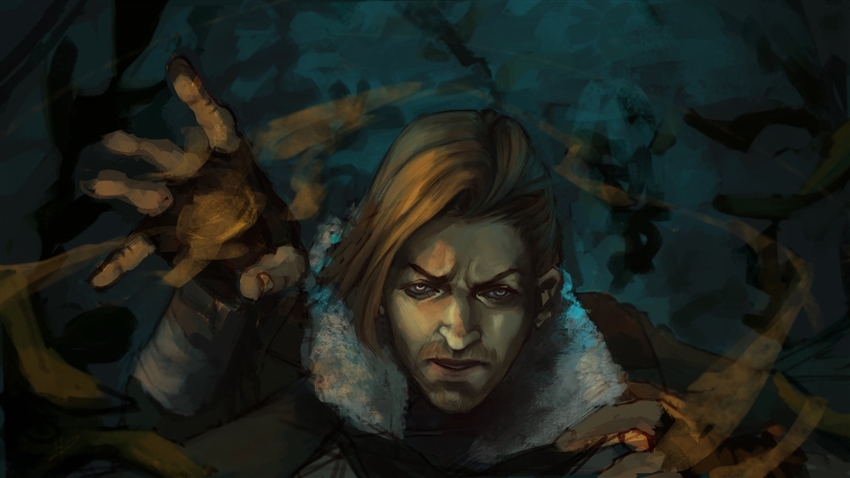Welcome to Critical Role Spotlight! We’re leaving the old Critical Role Recap series behind in 2018, I’m afraid, but I’m very excited to share a brand-new Critical Role article series with you. Last year, I gave you a full recap of every main-series episode of Critical Role, along with a single-paragraph summary of its events, just in case you needed to binge a dozen recaps to catch up.
Never fear, the short summaries will remain, but I’ll hide them behind a spoiler box. This is because the Critical Role Spotlight will focus on a single event or concept that happened in this week’s episode. There may be some mild spoilers—like a type of enemy fought, an environment the party explored, a magic item they found—but I’ll steer completely clear of major character beats. So please don’t worry if you weren’t able to catch the episode live on Thursday night. You can still read this article!
This week, we’re shining a spotlight on underwater combat, its quirks, and how you can make it feel different from combat on land without making it annoying for your players and a bookkeeping headache for you.
Short Summary
Previously on Critical Role, the Mighty Nein traveled to the Gravid Archipelago in search of the third and final orb of Uk’otoa—the demigod spawn of Zehir the Cloaked Serpent. In the waters surrounding this chain of islands was a crumbling, sunken tower. They descended into the structure, and within its depths they were accosted by a group of deep scions and chuul—and combat began.
This episode, the Mighty Nein battled a group of creatures who were corrupted by Uk’otoa’s defiling influence: deep scions and chuul. With their foes defeated, they explored the sunken structure, acquired some magical treasure, and Fjord placed his falchion in a tell-tale divot in the masonry. Everyone fled—save for Frumpkin, who Caleb was using to see through—and Fjord had another vision, this time being granted a vision of the vast Quoraska Jungle to the south.
Once reunited, the Might Nein boarded their ship, the Ball Eater, and made to escape—but a mysterious vessel flying no colors moved to intercept them! They fled, but a well-placed casting of control water by Caduceus capsized the pursuing vessel. The Ball Eater turned about to rescue and capture the survivors, who were apparently just opportunists. Fjord, perturbed by his visions and the ramifications of his quest, put his foot down and opted to end this nautical adventure. He and the Mighty Nein sailed back to Nicodranas and gave their tortle companion Orly command of the Ball Eater in their absence. He accepted the duty with gratitude, and said that he awaited Fjord’s return.

Detail of an illustration by Kent Davis (@iDrawBagman)
Spotlight: Grappling with Underwater Combat
The Mighty Nein engaged in two types of aquatic combat this week: fighting underwater, and fighting ship-to-ship. Aquatic combat can be challenging for players and DMs alike, so let’s take a look at how we can make it easier for everyone. Ship-to-ship combat is part of a recent Unearthed Arcana playtest, and unfortunately the Mighty Nein didn’t spend too much time in naval combat. Maybe we’ll return to the topic of naval combat in the future, but let’s focus on underwater combat for now.
Underwater Combat
The rules for fighting underwater are actually quite simple. They only take up two paragraphs (plus one sentence) in the Player’s Handbook. These points boil down to:
- Melee weapon attacks made underwater have disadvantage. Exceptions: unless the attacker has a swim speed, or unless the weapon is a dagger, javelin, shortsword, spear, or trident. Note that this excludes melee spell attacks.
- Ranged weapon attacks made underwater have disadvantage, and automatically miss beyond short range. Exception: unless the weapon is a crossbow, net, or is thrown like a javelin (like a spear, trident, or dart).
- Fully submerged creatures and objects have resistance to fire damage.
Note also the general rule that water is difficult terrain for all creatures without a swim speed.
There’s a fair bit of at-the-table complexity baked into all that. The DM can tell everyone that their attack rolls have disadvantage, but then you need to remember all the exceptions. Daggers, javelins, shortswords… and so on. Fortunately, the DM rarely has to consider this sort of thing, since the sort of creatures the player characters will be fighting underwater tend to have a swim speed and wield “javelin-like” ranged weapons, thus negating this whole hullabaloo. The game’s designers have your back, DMs.

It’s rare for player characters to gain a swim speed, but certain magic items like Fjord’s mariner’s armor can provide this benefit. This is the biggest hurdle on paper, but there is one more major issue that players and DMs both have to contend with.
Three-Dimensional Combat. Underwater and aerial combat share one major thing in common. They take place in 3-D space. Or more accurately, they take place in a space where all combatants can move three-dimensionally. When fighting creatures on land, one can generally expect all combatants to have their feet on the ground, except for when they climb a tree, cast a fly spell, or do something unusual like spider climb their way up a cave wall. But in water—and in encounters where all combatants can fly—vertical positioning becomes the norm, rather than the exception.
There’s a constant tension between making your underwater fights feel different from the 2-D ones that take place on land, and overcomplicating your fights with 3-D environments and unique mechanics. I can’t teach you how to think three-dimensionally, or give you a perfect answer for your group, but here’s a super-simple rule of thumb: monsters always try to get above an enemy. It’s easier to shoot down than it is to shoot up, and most humanoids have a harder time swinging their arms upwards (out of their comfortable field of both vision and reach) to strike an assailant than down.
If you don’t mind introducing a little bit of extra mechanical complexity, consider this house rule:
If you are at least 10 feet above a creature while fighting underwater, you have advantage on ranged attacks against that creature. Additionally, if you are adjacent to a creature and above it while fighting underwater, you have advantage on melee attacks and Strength (Athletics) checks made to grapple that creature.
The biggest challenge with three-dimensional combat is keeping track of where everyone is. Now, you could always take Mike Shea’s advice and just switch to Theater of the Mind combat, but I find that people have a hard enough time keeping track of positioning in two dimensions when playing Theater of the Mind-style. This is especially true when the DM has a half dozen monsters fighting. I don’t know about you, but I can’t mentally keep track of nearly a dozen individual monsters and characters all arrayed like a 3-D scatter plot.
Most D&D players have a vinyl 1”-grid battlemat at home. They’re great for keeping track of positioning in a 2-D environment, but your battlemat will need at least a little bit of enhancement to work in three dimensions. I use the little plastic boxes that Chessex dice come in as stands for character minis to represent that they’re flying, but that method is very limited. It only shows that they’re in the air, not how high. And when everyone is fighting with a variable height, just putting everyone on a little box doesn’t mean anything at all.
If your group doesn’t mind spending a little bit of money, there are plenty of RPG accessory companies that make elevation indicator tools. This one is particularly nice, as it has markings along the side like a graduated cylinder which you can use to mark your character’s height. I recommend using the sea floor as 0 when using this tool, unless the sea floor is too far away or too uneven to be a useful indicator. If you and your friends don’t want to spend any money, each player can keep a piece of scrap paper and track their own elevation on it. Again, I recommend using the sea floor as elevation 0.

Art by Hunter Fieseler (@rocketbyte_)
Casting Spells Underwater
As with everything in Dungeons & Dragons, we need to take a moment to discuss spellcasting. D&D is based around broad, general rules and countless exceptions that bend them. Spells are almost always exceptional. First, note that most sources of fire damage are spells. Any creature that’s underwater inherently has resistance to fire damage. If the creature already has fire resistance, it doesn’t get “double resistance,” you still only halve the damage once. If the submerged creature is vulnerable to fire damage, it naturally cancels out and takes normal damage.
For this reason, you’ll want to avoid preparing spells that deal fire damage when planning on taking a trip underwater.
According to a Sage Advice clarification by Jeremy Crawford, casting spells with verbal components underwater requires you to talk, and thus stop holding your breath. This is a big deal, as once you’ve let go of a big gulp of air underwater… well, there’s really no way of getting it back again. Unless you can breathe underwater, take great caution before casting spells with verbal components.
Players and DMs, here are some spells you want to have in your arsenal when fighting underwater, or preparing to fight underwater.
- Water breathing. This 3rd-level spell is practically vital for underwater dungeon exploration. Fortunately, it affects up to 10 willing creatures you can see, so you can give your entire party and probably all your NPC friends the ability to breathe underwater for a full 24 hours. If you don’t have access to 3rd-level spells, several magic items like the cap of water breathing and the potion of water breathing also provide similar effects. Also, if you can breathe water, you can cast spells with verbal components without worry.
- Freedom of movement. In addition to granting one creature immunity to being paralyzed and grappled, freedom of movement also removes the penalties to movement and attacks that come from being underwater!
- Control water. Caduceus and Jester showed off the raw power of this spell this week. When an entire fight is taking place underwater, being able to control water grants you near-total control over the battlefield.
- Water walk is mostly useful for avoiding underwater combat scenarios, but it’s a great panic button while fighting underwater, since it causes affected creatures to rocket up to the surface of the water.
Some other good suggestions were made in this Reddit comment. Tasha’s hideous laughter is an inspired choice against enemies that can’t naturally breathe underwater!
What lessons can we learn from Matthew Mercer and the Mighty Nein next week? Is it Thursday yet?
Unless otherwise credited, all images in this article are courtesy of Chris Lockey and Critical Role.
 James Haeck is the lead writer for D&D Beyond, the co-author of Waterdeep: Dragon Heist and the Critical Role Tal'Dorei Campaign Setting, the DM of Worlds Apart, and a freelance writer for Wizards of the Coast, the D&D Adventurers League, and Kobold Press. He loves watching Critical Role and wants everyone he knows to get into it, too. He lives in Seattle, Washington with his partner Hannah and his very own Frumpkins, Mei and Marzipan. You can usually find him wasting time on Twitter at @jamesjhaeck.
James Haeck is the lead writer for D&D Beyond, the co-author of Waterdeep: Dragon Heist and the Critical Role Tal'Dorei Campaign Setting, the DM of Worlds Apart, and a freelance writer for Wizards of the Coast, the D&D Adventurers League, and Kobold Press. He loves watching Critical Role and wants everyone he knows to get into it, too. He lives in Seattle, Washington with his partner Hannah and his very own Frumpkins, Mei and Marzipan. You can usually find him wasting time on Twitter at @jamesjhaeck.








-
View User Profile
-
Send Message
Posted Jan 11, 2019I like this format better than the recap! Doing a deep dive on some mechanics on how the rules work and how we as players and DMs can better understand what happens in these situations is massively helpful.
-
View User Profile
-
Send Message
Posted Jan 11, 2019Last night Sam Riegel announced that he is running for President (of D&D Beyond)!
#SamForPresident
Sam Riegel for President (of D&D Beyond) - Adohand’s Kitchen - Off-Topic - D&D Beyond Forums - D&D Beyond
https://www.dndbeyond.com/forums/off-topic/adohands-kitchen/31278-sam-riegel-for-president-of-d-d-beyond
I hope that Sam's first act as president will be to convince Liam to use D&D Beyond to look up his spells instead of using a physical copy of the Player's Handbook.
-
View User Profile
-
Send Message
Posted Jan 11, 2019Remember, when the DM shakes their head and puts away a stack of notes while trying to reassure you that everything is okay, it's not really okay.
I'm sure I speak for all of my fellow DM's out there when I say "we feel your pain Matt Mercer."
-
View User Profile
-
Send Message
Posted Jan 11, 2019Good article! These spotlights will be interesting!
Just a correction: water isn't "difficult terrain". "Each foot of movement costs 1 extra foot (2 extra feet in difficult terrain) when you’re climbing, swimming, or crawling." (PHB ch. 8)
The difference is subtle yet important because difficult terrains do not stack, but you could technically create an effect (with spell or feature) that creates difficult terrain and *that* would stack with the swimming penalty. (Which is why text specifies "2 extra feet in difficult terrain").
-
View User Profile
-
Send Message
Posted Jan 11, 2019One element of underwater combat that sometimes create confusion is what happens if you're knocked prone? Jeremy Crawford wrote on Twitter: "If you're knocked prone underwater, you're subjected to the effects of the prone condition as normal. One way to visualize it is that you're floundering."
-
View User Profile
-
Send Message
Posted Jan 11, 2019The idea of a spotlight series for a particular element of each week's episode certainly is interesting and I will keep up with it. But to be honest, the loss of the detailed summary is really disappointing. I get that your time is finite, and I'm a free consumer of these articles. I'm just sad to lose an article style I read and looked forward to the most.
Nah, as a DM, I recognize why Matt was honest about his reassurances. It's these kind of moments that put the DMs in the player's seats, when we can get our chance to see the story unfold like they do. As a DM, it's a melancholic joy, far from "not okay." Melancholic because you know what was lost, but still a joy because you got something better in the exchange.
-
View User Profile
-
Send Message
Posted Jan 11, 2019Thanks James! The new format is awesome!
-
View User Profile
-
Send Message
Posted Jan 11, 2019I'm sure he was very proud of Talisen for coming up with such an innovative solution to the encounter, but I'm fairly sure that tears were shed once the cameras were off.
It sounded like he had consulted with Mike Mearls on this encounter. He seemed very proud of his work.
It may have been melancholy or bittersweet, or both, but you could tell by the look on his face that it hurt.
-
View User Profile
-
Send Message
Posted Jan 11, 2019Sure, this article is fine and whatnot, but can someone link me to a website that still does recaps of Critical Role? I don't have time to watch nor listen to the show, but I still want to keep up to date. Much appreciated.
-
View User Profile
-
Send Message
Posted Jan 11, 2019Geek & Sundry releases video recaps of Critical Role every week on their YouTube channel. Their recaps come out just before a new episode debuts every Thursday, so the recap of episode 47 will come out next Thursday.
-
View User Profile
-
Send Message
Posted Jan 11, 2019While I can understand the recaps being beneficial for those who want to keep up with the show but don't have time to watch, I always felt the recap was written in a rushed manner. Details, big or small, were slightly off compared to what actually happened in the episode and there were usually comments to help clarify those mistakes. With most episodes running close to 4 hours, that's a lot of content to parse down into a readable article the next morning.
I agree that he was honest that it was ok, I've had a lot of cool things ready to go for my players that have been cast to the side because they did something unexpected that bypassed it altogether.
I think the best recaps are done by Dani Carr from the CR team with Critical Recap. It's usually less than a 5 minute video done a week after the episode that hits all the important story bits and adds short clips of important moments from the show. Here's the playlist. As far as a recap for this week, there's no other place that I've found that has a consistent schedule on having an article about the episode.
-
View User Profile
-
Send Message
Posted Jan 12, 2019What happens when an creature is using a spell such as water walk, and fires a projectile such as an arrow at a creature underwater? Would the rules of underwater combat apply then?
-
View User Profile
-
Send Message
Posted Jan 12, 2019I agree that Dani's recaps are excellent and probably your best bet, but I just wanted to point out that Project Derailed also does text recaps of the episodes--or, at least, they used to. Seems like the most recent one they have is C2E29, so they're missing roughly the last twenty and I'm not sure why (temporary break, stopped altogether, etc.--I dunno, maybe they stopped because CR started doing their own recaps with Dani). Still, may be worth checking occasionally in case they get caught up again.
-
View User Profile
-
Send Message
Posted Jan 12, 2019Yeah, this is much cleaner. Love critical role and it’s relationship to DnD Beyond, but can already see more value in this approach. Nice tie in.
-
View User Profile
-
Send Message
Posted Jan 12, 2019Regarding the comment on difficult terrain plus being underwater changing movement speed my thoughts are...
wait...
...yes....
muahahahahah!
-evil DM
-
View User Profile
-
Send Message
Posted Jan 12, 2019This is great. I haben’t read the previous revaps, because I don’t watch Critical Role. But theis style is worth reading whether you watch it or not.
-
View User Profile
-
Send Message
Posted Jan 12, 2019In 3-D fights we use "stands" and then mark it with a die to indicate how high they are in 10' increments. Stands are what ever we have handy. One time we were doing a game as a part of a wedding celebration and the candelabra on the center table had 10 arms each able to move into a variety of positions independent of each other. As soon as I saw that I knew we were going to have a 3-D combat just to use it.
-
View User Profile
-
Send Message
Posted Jan 13, 2019So are you not going to be doing the full episode recaps any more then?
-
View User Profile
-
Send Message
Posted Jan 13, 2019I’d like to recommend the spell Alter Self:
”Aquatic Adaptation. You adapt your body to an aquatic environment, sprouting gills and growing webbing between your fingers. You can breathe underwater and gain a swimming speed equal to your walking speed.”
-
View User Profile
-
Send Message
Posted Jan 14, 2019I appreciate the format change!